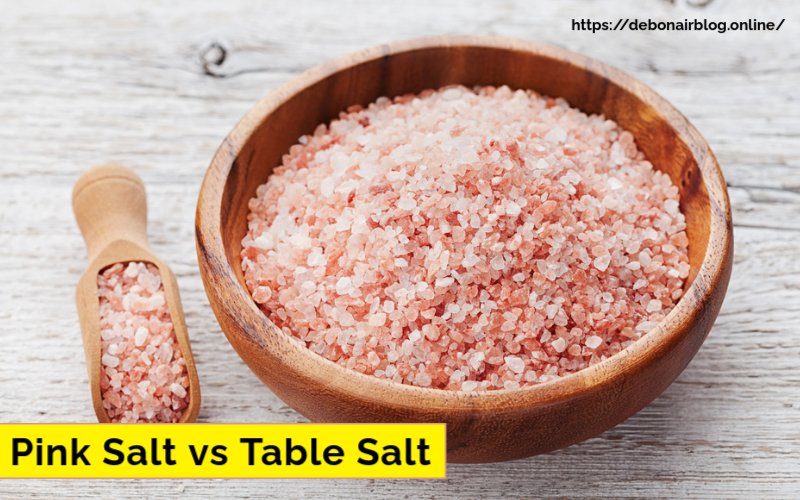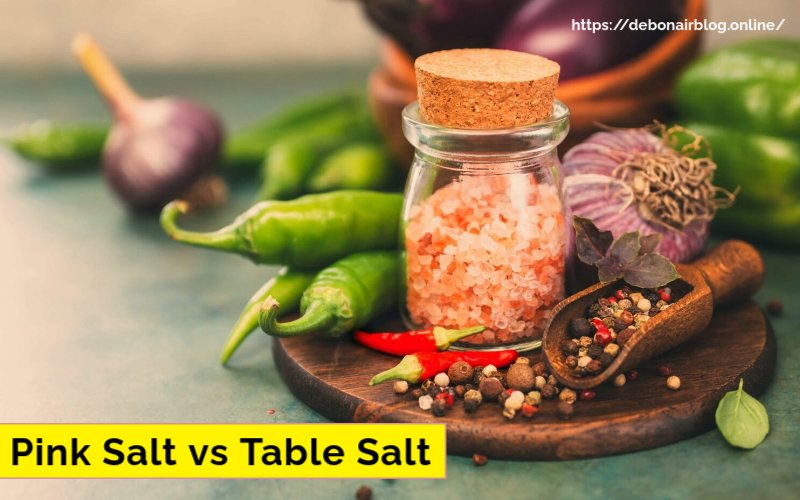
Pink Salt vs. Table Salt: Which One Should You Choose in 2024?
Table of Contents
When it comes to seasoning our food, salt is an essential ingredient that has been used for centuries. But with so many types of salt available today, many people find themselves wondering: Is pink salt better than table salt?
In this article, we’ll explore the differences between Himalayan pink salt and regular table salt, discussing their health benefits, nutritional values, potential risks associated with heavy metal contamination, and various uses. By the end, you’ll have a clearer understanding of which type of salt might be the best choice for you.
What is Himalayan Pink Salt?
Himalayan pink salt is a naturally occurring mineral harvested from the Khewra Salt Mine in Pakistan, located near the Himalayas. This beautiful pink salt is known not only for its unique color but also for its purported health benefits.
The salt is believed to contain up to 84 trace minerals, including potassium, magnesium, and calcium, which contribute to its vibrant hue and distinct flavor.Unlike regular table salt, which undergoes extensive processing and often contains additives like anti-caking agents and iodine, Himalayan pink salt is typically less processed.
This means it retains more of its natural minerals. Many people are drawn to pink salt because they believe these minerals provide additional health benefits that regular table salt lacks.
The Basics of Table Salt
Table salt, on the other hand, is primarily composed of sodium chloride and is usually mined from underground salt deposits or produced by evaporating seawater. During processing, impurities are removed, and additives are often included to prevent clumping and to ensure adequate iodine levels in the diet.
Iodine is an essential nutrient that supports thyroid function and overall health. For this reason, many health professionals recommend iodized table salt as a reliable source of iodine in our diets. However, the refining process strips table salt of its natural minerals, making it less appealing for those seeking a more “natural” seasoning option.
Nutritional Comparison: Pink Salt vs. Table Salt
When comparing the nutritional profiles of Himalayan pink salt and table salt, it’s essential to consider their sodium content as well as the trace minerals present in each.
| Nutrient | Himalayan Pink Salt | Table Salt |
|---|---|---|
| Sodium (mg) | 368 | 381 |
| Calcium (mg) | 1.6 | 0.4 |
| Potassium (mg) | 2.8 | 0.9 |
| Magnesium (mg) | 1.06 | 0.0139 |
| Iron (mg) | 0.0369 | 0.0101 |
While table salt has a slightly higher sodium content, Himalayan pink salt contains small amounts of beneficial minerals that may contribute to overall nutrition.
However, it’s important to note that the quantities of these minerals are relatively low; you would need to consume large amounts of pink salt to obtain significant health benefits from them.
Health Benefits of Pink Salt

Many proponents of Himalayan pink salt claim that it offers various health benefits compared to regular table salt. Some of these claims include:
- Improved respiratory function: Some people believe that using pink salt lamps or spending time in salt caves can help alleviate respiratory diseases by purifying the air.
- Better skin health: Bathing in water infused with pink Himalayan salt has been suggested as a remedy for skin conditions like eczema.
- Balanced pH levels: It’s claimed that pink salt can help maintain the body’s pH balance.
- Enhanced sleep quality: Some believe that consuming pink salt can improve sleep patterns.
- Increased libido: There are claims that this mineral-rich salt can boost sexual desire.
While these claims sound appealing, scientific evidence supporting them is limited. Most studies suggest that any potential benefits are likely due to sodium chloride’s role in bodily functions rather than specific properties unique to Himalayan pink salt.If like healthy food you might like to read these articles:
Scientific Research on Health Claims
Research on Himalayan pink salt’s health benefits has yielded mixed results. For instance:
- A study published in PubMed analyzed various samples of Himalayan pink salt available in Australia and found one sample contained lead levels exceeding safety standards set by Food Standards Australia New Zealand.
- Another study highlighted that while trace minerals in Himalayan pink salt may offer some benefits, they are present in such small quantities that significant health advantages are unlikely from dietary intake alone.
The Role of Sodium in Our Diet
Sodium plays a crucial role in maintaining fluid balance within the body and is necessary for proper nerve function and muscle contraction. However, excessive sodium intake can lead to high blood pressure and increase the risk of cardiovascular diseases.
The American Heart Association recommends limiting sodium intake to about 2,300 milligrams per day—roughly equivalent to one teaspoon of table salt. Since both Himalayan pink salt and table salt contain similar amounts of sodium per teaspoon, moderation is key regardless of which type you choose.
Risks Associated with Heavy Metal Contamination
One significant concern regarding Himalayan pink salt is the potential presence of heavy metals like lead and cadmium due to environmental contamination during mining or poor manufacturing practices.
Health Risks Associated with Lead Exposure
Lead exposure poses serious health risks:
- Neurological Effects: Lead can impair cognitive development in children and result in memory loss or mood disorders in adults.
- Kidney Damage: Chronic exposure may lead to kidney dysfunction or chronic kidney disease.
- Reproductive Health Issues: Lead can affect fertility and cause complications during pregnancy.
- Increased Cancer Risk: Cadmium exposure has been linked to kidney damage and cancer risk.
Given these risks, it’s crucial for consumers to source Himalayan pink salt from reputable brands that conduct regular testing for contaminants.
Cooking with Pink Salt: A Flavor Adventure

One of the most exciting aspects of Himalayan pink salt is its versatility in cooking! You can use it just like regular table or sea salts—sprinkling it on dishes or incorporating it into recipes. Some chefs even use large blocks of pink salt for grilling or serving food, adding not only unique flavor but also an eye-catching presentation.
Imagine grilling a steak on a sizzling hot block of Himalayan pink salt! The meat absorbs subtle flavors while cooking evenly—a culinary experience unlike any other! Just remember: when cooking with pink salt, you may need to adjust your measurements since its larger crystals can affect how much sodium you’re actually using.
Beyond Cooking: Non-Dietary Uses of Pink Salt
Himalayan pink salt isn’t just for seasoning your food; it has gained popularity for various non-dietary uses as well:
- Bath Salts: Many people add pink Himalayan salt to their baths for relaxation and potential skin benefits.
- Salt Lamps: These lamps are made from large blocks of Himalayan pink salt and are believed by some to improve air quality by releasing negative ions.
- Salt Caves: Spending time in man-made caves filled with Himalayan pink salt is thought to help with respiratory issues.
While these uses are popular among wellness enthusiasts, scientific evidence supporting their effectiveness remains limited.
Potential Side Effects of Pink Salt
Despite its many touted benefits, consuming too much Himalayan pink salt can lead to similar side effects as regular table salt:
- High Blood Pressure: Excessive sodium intake can raise blood pressure levels.
- Kidney Problems: High sodium consumption may increase the risk of chronic kidney disease.
- Osteoporosis Risk: Too much dietary sodium can lead to calcium loss through urine.
- Thyroid Issues: Since Himalayan pink salt typically contains less iodine than iodized table salts, relying solely on it may lead to iodine deficiency if not compensated through diet.
It’s essential to be mindful of your overall sodium intake regardless of whether you choose pink or regular table salt.
Making an Informed Choice
Choosing between Himalayan pink salt and regular table salt ultimately comes down to personal preference and dietary needs. If you’re looking for a more natural option without additives and enjoy the unique flavor profile of pink Himalayan salt, it might be worth incorporating into your diet.However, if you require adequate iodine intake or prefer a more cost-effective option for seasoning your meals, iodized table salt remains a reliable choice.
FAQs About Pink Salt vs. Table Salt
1. Is Himalayan pink salt healthier than regular table salt?
While some claim it has additional health benefits due to trace minerals, both salts contain similar amounts of sodium per serving.
2. Can I use Himalayan pink salt in baking?
Yes! You can use it just like regular table or sea salts in baking recipes.
3. Does Himalayan pink salt contain iodine?
Typically, no; it contains much lower levels than iodized table salts.
4. Are there any side effects associated with using too much Himalayan pink salt?
Yes; excessive consumption can lead to high blood pressure and other health issues similar to those caused by regular salts.
5. How does the taste differ between Himalayan pink and table salts?
Himalayan pink salt has a slightly different flavor profile due to its mineral content but generally tastes similar when used in cooking.
6. Can I use Himalayan pink salt for my skin?
Some people add it to baths for potential skin benefits; however, scientific evidence is limited.
7. Is there any scientific research supporting the health claims about Himalayan pink salts?
Most claims lack substantial scientific backing; more research is needed on its purported benefits.
8. How should I store my Himalayan pink salts?
Store them in an airtight container away from moisture for optimal freshness.
9. Can I use both types of salts interchangeably?
Yes; just be mindful of their different textures when measuring quantities.
10. What’s the best way to incorporate more minerals into my diet?
Focus on whole foods rich in minerals rather than relying solely on salts for nutrition.
11. Are there any cooking methods specifically suited for using block salts?
Yes; grilling or searing meats on a block can impart unique flavors while cooking them evenly.
12. How do I know how much sodium I’m consuming from my diet?
Check nutrition labels on packaged foods and keep track of added salts during cooking at home.
Real-Time Case Study: A Family’s Journey with Pink Salt
The Johnson family decided to switch from regular table salt to Himalayan pink salt after hearing about its potential health benefits from friends and social media influencers. They began using it not only in their cooking but also purchased a few decorative lamps made from the same mineral for their home.
After several months, they noticed no significant changes in their overall health or energy levels but enjoyed experimenting with different recipes using their new favorite seasoning. They found that while they loved the taste and aesthetic appeal of the lamps, they still needed to ensure they were getting enough iodine through other dietary sources like dairy products and seaweed.
Conclusion:
In conclusion, while both types of salts have their pros and cons, understanding your dietary needs will help you make an informed decision about which one suits your lifestyle best!

